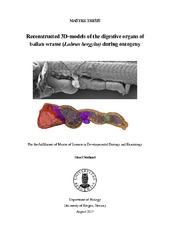| dc.description.abstract | This study describe the ontogeny of the digestive tract and it’s associated glands of ballan wrasse at six reference stages from yolk sac larva (Stage 1; 4 DPH) until juvenile phase (Stage 6; 102 DPH). Reconstructed 3D-models based on histological sections were made by Imaris 3D rendering software. Statistical data from the 3D-models were retrieved to study morphometric scaling of the digestive organs and relate the scaling to functional capacity of digestion and processing. Finally, the data were used to explore morphological and histological evidence for the possible presence of an intestinal bulb in the proximal midgut in the agastric ballan wrasse. At Stage 1; 4 DPH the larva had a straight incipient gut located dorsally for the yolk sac along with liver, gallbladder and exocrine pancreas containing few zymogen granules, demonstrating a functional digestive system ready for onset of exogenous feeding. All organs had a strong growth in both surface areas and volumes until Stage 2; 10 DPH. At this stage, an intestinal bulb was observed as an expansion in diameter in the proximal midgut. In addition, there were folding of the intestinal epithelium (villi) and a valve between distal midgut and hindgut was clearly differentiated, as was an endocrine pancreas. The beginning of intestinal rotation (into one loop) were seen at Stage 3; 18 DPH. At this stage, the exocrine pancreas had become more scattered. The ducts from the gallbladder and exocrine pancreas terminated in the anterior part of the bulbus. The bulbus may increase the residence time of ingested food in this segment and thus increase the efficiency of mixing feed with bile and pancreatic secretions. As the larvae grew (Stages 4 to 6; 29-102 DPH), the intestinal bulb persisted only as a slight enlargement of the proximal midgut. The intestinal villi became larger concurrent with elongated liver and formation of hepatopancreas from Stage 5; 71 DPH. The digestive tract of this agastric fish did not show consistent evidence of a functional bulbus with presence of a distinct narrowing of the luminal diameter with an increased muscle layer at the end of the bulbus. The morphometric scaling demonstrated allometric growth of the digestive organs. The relative volume (mass) of gut tissue decreased compared to the other organs during ontogeny; gut tissue declined from 79% to 62%, liver and exocrine pancreas increased from 21% to 38 from Stage 1 to 6. During this time, intestinal mucosal surface area-to-volume ratio decreased from 0.33 (incipient, straight intestine) to 0.02 μm-1 (highly folded). The relative increase in growth of the liver and exocrine pancreas indicate an increased digestive capacity by pancreatic secretions and capacity for post-prandial metabolism by the liver. The specific growth rate of the endocrine pancreas was higher compared to the other tissues and organs; 16.94% day-1 for endocrine pancreas, 6.18-7.12% day-1 for gut tissue, liver and exocrine pancreas, respectively. This may suggest an altered capacity for postabsorptive hormonal and metabolic handling of absorbed nutrients as the ballan wrasse goes through ontogeny. | en_US |
